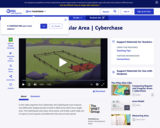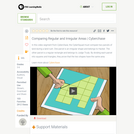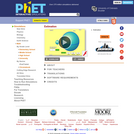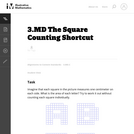
This resource links to both Measurement & Data progression documents published by the Common Core Writing Teams in June 2011.
- Material Type:
- Assessment
- Homework/Assignment
- Teaching/Learning Strategy
- Date Added:
- 05/09/2013

This resource links to both Measurement & Data progression documents published by the Common Core Writing Teams in June 2011.

In this video segment from Cyberchase, the CyberSquad measures Judge Trudy's land claim by using tarps, fence posts and a grid made with rope.

The CyberSquad proves that the area of Hacker's land is equal to the area of Judge Trudy's land in this video segment from Cyberchase.

Math unit about understanding Perimeter and Area using Khan Academy materials. Appropriate for grades 3-5.

This interactive Flash animation allows students to explore size estimation in one, two and three dimensions. Multiple levels of difficulty allow for progressive skill improvement. In the simplest level, users estimate the number of small line segments that can fit into a larger line segment. Intermediate and advanced levels offer feature games that explore area of rectangles and circles, and volume of spheres and cubes. Related lesson plans and student guides are available for middle school and high school classroom instruction. Editor's Note: When the linear dimensions of an object change by some factor, its area and volume change disproportionately: area in proportion to the square of the factor and volume in proportion to its cube. This concept is the subject of entrenched misconception among many adults. This game-like simulation allows kids to use spatial reasoning, rather than formulas, to construct geometric sense of area and volume. This is part of a larger collection developed by the Physics Education Technology project (PhET).

This is a rectangle subdivision task; ideally instead of counting each square. students should break the letters into rectangles, multiply to find the areas, and add up the areas. However, students should not be discouraged from using individual counting to start if they are stuck. Often students will get tired of counting and devise the shortcut method themselves.